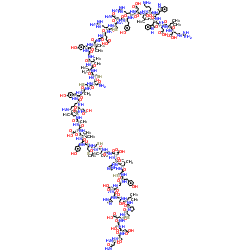Epidermal Growth Factor

Epidermal Growth Factor structure
|
Common Name | Epidermal Growth Factor | ||
|---|---|---|---|---|
| CAS Number | 62253-63-8 | Molecular Weight | 6221.96723999994 | |
| Density | N/A | Boiling Point | N/A | |
| Molecular Formula | C270H401N73O83S7 | Melting Point | N/A | |
| MSDS | USA | Flash Point | N/A | |
Use of Epidermal Growth FactorEpidermal growth factor (EGF) is the key regulatory factor in promoting cell survival. Epidermal growth factor (EGF) signaling pathways are related with apoptosis. Loss of Epidermal growth factor (EGF) leads to embryonic or perinatal lethality with abnormalities in multiple organs. Epidermal growth factor (EGF) can stimulate reactive oxygen species (ROS) production for a short period of time in cells. Epidermal growth factor (EGF) can be used to research development and cancer[1][2]. |
| Name | Epidermal Growth Factor |
|---|---|
| Synonym | More Synonyms |
| Description | Epidermal growth factor (EGF) is the key regulatory factor in promoting cell survival. Epidermal growth factor (EGF) signaling pathways are related with apoptosis. Loss of Epidermal growth factor (EGF) leads to embryonic or perinatal lethality with abnormalities in multiple organs. Epidermal growth factor (EGF) can stimulate reactive oxygen species (ROS) production for a short period of time in cells. Epidermal growth factor (EGF) can be used to research development and cancer[1][2]. |
|---|---|
| Related Catalog | |
| Target |
Apoptosis, ROS[1][2] |
| In Vitro | Epidermal growth factor (EGF) (500 ng/mL; 0-20 min) can induce the production of ROS in A431 cells[1]. Epidermal growth factor (EGF)-induced tyrosine phosphorylation of various cellular proteins was completely blocked in A431 cells containing exogenous catalase[1]. |
| In Vivo | Epidermal growth factor (EGF) (Osmotic pump delivered over 8 days at 10 pg/day) exhibits a highly significant stimulatory effect on wound closure in male mice[3]. Animal Model: C57BL6J and CBA mice (0.5-cm2 full-thickness back wound was cut out of the center of the back)[3] Dosage: 10 μg/day Administration: Osmotic pump delivered over 8 days at 10 pg/day Result: Exhibited a highly significant (P < 0.001) stimulatory effect on wound closure over 6 days in male mice. |
| Molecular Formula | C270H401N73O83S7 |
|---|---|
| Molecular Weight | 6221.96723999994 |
| Appearance of Characters | powder |
| Storage condition | 2-8°C |
| Personal Protective Equipment | Eyeshields;Gloves;type N95 (US);type P1 (EN143) respirator filter |
|---|---|
| RIDADR | NONH for all modes of transport |
| WGK Germany | 3 |
| RTECS | KB4518000 |
|
Neuropilin 1 is an entry factor that promotes EBV infection of nasopharyngeal epithelial cells.
Nat. Commun. 6 , 6240, (2015) Epstein-Barr virus (EBV) is implicated as an aetiological factor in B lymphomas and nasopharyngeal carcinoma. The mechanisms of cell-free EBV infection of nasopharyngeal epithelial cells remain elusiv... |
|
|
Neurobehavioral Differences Between Mice Receiving Distinct Neuregulin Variants as Neonates; Impact on Sensitivity to MK-801.
Curr. Mol. Med. 15 , 222-36, (2015) Neuregulin-1 (NRG1) is a well-recognized risk gene for schizophrenia and is often implicated in the neurodevelopmental hypothesis of this illness. Alternative splicing and proteolytic processing of th... |
|
|
Inhibition of non-small cell lung cancer (NSCLC) growth by a novel small molecular inhibitor of EGFR.
Oncotarget 6(9) , 6749-61, (2015) The epidermal growth factor receptor (EGFR) is a therapeutic target (oncotarget) in NSCLC. Using in vitro EGFR kinase activity system, we identified a novel small molecule, WB-308, as an inhibitor of ... |
| nepidermin |
| MFCD00132565 |
| EINECS 263-468-7 |
| rh-EGF |

